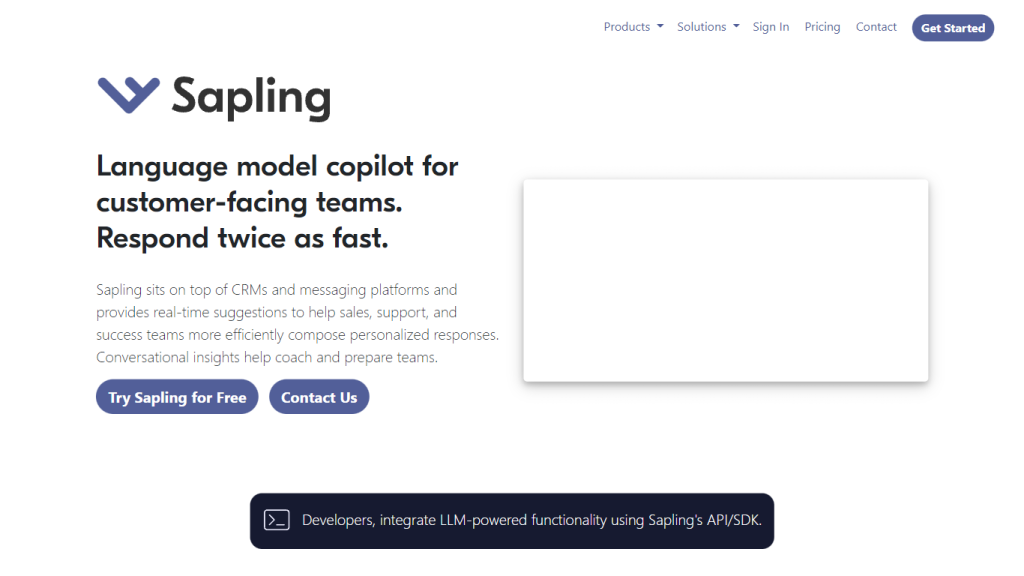What is Sapling?
Sapling is an AI language model for customer-facing teams. Sapling integrates with advanced models for increased quality and efficiency in customer interactions. This powerful tool offers real-time suggestions to help customer service representatives deliver responses that are exact, personalized, and timely-feasible in nature. This in turn increases overall customer satisfaction.
Key Features & Benefits: Sapling
Sapling provides everything from simple autocompletion and grammar checks to deeper custom content governance. These features make it invaluable to a wide array of businesses, including:
- Ones that use Autocomplete to help them draft responses fast when trying to predict the next word or phrase.
- Ones using Snippet Macros, where they have predefined text snippets to save time.
- Ones focused on Grammar Checks, ensuring all communications are grammatically correct.
- Ones that employ Custom Content Governance, giving full control over the quality and type of content being shared.
- Knowledge Sharing: It allows sharing useful information and insights among team members.
- Messaging Platforms: This can be integrated into all existing messaging and CRM systems.
These features put together will accelerate the response time, lessen the linguistic errors, and better manage the customers’ interactions for business success.
Sapling Use Cases and Applications
Sapling has a wide range of industries and sectors it caters to:
-
Customer Service:
The representatives will be able to answer the customers’ questions with more valid and respectful responses. -
Sales Teams:
Drives sales representatives to handle their tasks smoother, more efficiently, and contextual suggestions on the go. -
Support Teams:
Enhances problem solving of issues and provides timely solutions to them. -
Success Teams:
Assists in maintaining relationships with customers and in ensuring their satisfaction.
Due to the versatility in Sapling and magnitude of its language model, it is ready for anything from giving product information to personalized recommendations.
Using Sapling
How to use it, is not a big deal; it’s easy and intuitive. Here’s a step-by-step process:
-
Integration:
Integrate Sapling into your messaging or CRM platform via its powerful API. -
Configuration:
Set up the tool for your needs-family snippet macros, content governance rules, and more. -
Training:
Let Sapling learn from past interactions so that it improves with each response. -
Real Usage:
In real usage, use the suggestions, autocomplete, and grammar checks to respond to a customer in real time.
To get the most out of this resource, use the contextual prompts whenever possible and take some time to explore all that Sapling has to offer with your team.
How Sapling Works
Sapling incorporates advanced machine learning algorithms and models for effective performance. What follows is a simplified technical explanation:
-
Language Models:
It employs state-of-the-art language models that understand and build human-like text responses. -
Machine Learning:
It continuously learns from past interactions for better responses in the future. -
API Integration:
Allows for seamless integration into various platforms, enabling smooth workflow and automation.
This combination of technologies empowers Sapling to respond to customer queries with precision, relevance to context, and on time.
Pros and Cons of Sapling
Like every tool, the pros and cons of Sapling might be divided below:
Pros:
- Everything is real-time; therefore, suggestions and completions have an added advantage of saving hours.
- All grammar mistakes are taken out systematically, and quality communication is always ensured.
- Customizable, it can be tailored to fit the exact needs for a given business.
- Seamless integration with other platforms.
Cons:
- Takes time to be trained and optimized fully.
- Some may find the setup a bit complicated, and they might want to do more customization.
Generally speaking, users praise it for what it has done with customer service interactions.
How Much does Sapling Cost?
It comes with a Freemium pricing model to enable Saplings to be available to all classes of users, and that is as follows:
-
Free Plan:
It is absolutely free but comes with some limitations. -
Pro Plan:
It costs $25/month to get more features and capabilities. -
Metered Plan:
For customized pricing, get in contact with Sapling to base it on usage.
The pricing is flexible, and thus, businesses can get started for free and scale up as their needs evolve, which will always make it worth the money.
Conclusion about Sapling
In general, Sapling is a flexible and powerful AI tool intended for the improvement of customer-facing conversations. The advanced language models, real-time suggestions, and seamless integrations make it worth its weight in gold for any business looking to increase customer service quality and efficiency. From all the different features to the flexible pricing options, Sapling is more or less suited to respond to the needs of different industries and organizations.
In the future, many changes and updates will be done on this platform in order to widen its capabilities even more as an indispensable tool for customer-facing teams.
Sapling FAQs
-
What is Sapling?
Sapling is an AI language model copilot built to augment customer interactions with real-time suggestions and personalized responses. -
How can Sapling improve customer service?
Sapling can develop the customer service capability through real-time suggestions, autocompletion, and grammar checks, therefore allowing customer service representatives to respond quickly and accurately. -
How much does Sapling cost?
Sapling offers a Freemium pricing model, where you have the option between free, pro for $25 a month, and metered which has custom pricing. -
How do I get Sapling integrated into my current platform?
Sapling offers a strong API for integration into existing messaging and CRM platforms. -
Which industries benefit from using Sapling?
Sapling can be very versatile and benefit many sorts of industries, especially customer service, sales, support, and customer success teams.










